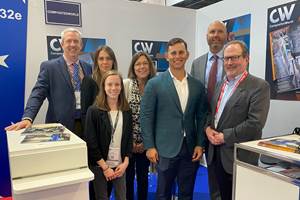Repairing flying composite structures
As the Boeing 787 nears first flight, certification and delivery and as the design of the Airbus A350 XWB is solidified, we hear more and more about how airlines that fly these planes might deal with maintenance and repair.
As the Boeing 787 nears first flight, certification and delivery and as the design of the Airbus A350 XWB is solidified, we hear more and more about how airlines that fly these planes might deal with maintenance and repair. When one considers the advantages that carbon fiber composites convey to a commercial jetliner — light weight, durability, strength — it’s easy to forget that the integration of a new material into an established product type has ancillary effects. It’s not that the use of carbon fiber in commercial planes is new; it’s that carbon fiber laminate will be used over so great a portion of the plane’s exterior — particularly in the fuselage.
Legacy tools and materials for repair of fuselage damage have, of course, focused exclusively on aluminum. The bulk of the MRO personnel within the aircraft industry are trained to fix aluminum structures. The equipment they use is designed to fix aluminum structures. Although the first 787 won’t enter service for another year, it’s clear that airlines are already thinking hard about how to address MRO on the 787 and the A350 XWB.
This month’s Market Trends (see “Related Content,” at left), by Mark Loyd, a composites expert at American Airlines in Tulsa, Okla., looks at the complexities of MRO in a carbon fiber environment and offers a glimpse of the kinds of challenges facing airlines in the years to come, ranging from titanium patches on carbon fiber surfaces to supply and storage issues for carbon fiber repair materials. That’s the thing about a paradigm shift: It forces an enterprise-wide reassessment of legacy tools, materials and practices.
With an eye on this situation, a team at Delft University (The Netherlands) is developing a new lightweight material for aircraft airframe construction (see News in “Related Content,” at left). It’s comprised of GLARE (thin layers of aluminum sheeting interleaved with a glass-reinforced composite material) used as a core between skins of a new aluminum-lithium alloy. One of the reported benefits of this sandwich construction is that repair can be done with existing materials and tools. Although Delft admits the material is at least five years from commercialization, it shows that aluminum hasn’t yet ceded the aircraft market to its carbon/epoxy competition.
A little closer to Earth, our feature this month on the use of carbon/carbon (C/C) in friction components (click “Friction products ….” in “Related Content,” at left) explores the material’s role in braking applications. This story asks you to consider the energy generated during the braking of a fully loaded 767: 737,000 ft-lb of force. A braking system sufficient to manage so much energy must do so by converting it to heat — hence the friction. C/C, given its lengthy manufacturing process, seems an unlikely candidate for braking applications, but the material’s performance, especially compared to metallic alternatives, makes it a very attractive option.
Our feature on CNC machinery (see “Managing multi-axis ….” in “Related Content,” at left) provides a survey of trends in the milling/drilling segment. What we find is that as demand for automation increases, machinery such as this becomes increasingly viable and attractive for advanced composites. In the sidebar that accompanies the piece, you get a taste tape laying machinery coverage to come in July 2008, when HPC will explore some of the most recent applications of this machinery and how to design parts and components with it in mind.
Related Content
Reading the Boeing tea leaves
Boeing CEO David Calhoun says not to expect a new aircraft before 2035. What are aerocomposites fabricators supposed to make of that?
Read MoreThe future of carbon fiber manufacture
Later this month, CW’s 25th anniversary Carbon Fiber Conference promises to be among the most important as dynamic market forces are putting unusual pressure on the carbon fiber supply chain.
Read MoreWhat to make of the first JEC World in three years
CW went to JEC World 2022 not sure what to expect. We were pleasantly surprised, and learned much about where and how new composites technologies are being developed.
Read MoreSustainability has come to composites and it's here to stay
It might be tempting to think of sustainability as a buzzword, but there are structural changes taking place in the composites industry that signal its permanence.
Read MoreRead Next
From the CW Archives: The tale of the thermoplastic cryotank
In 2006, guest columnist Bob Hartunian related the story of his efforts two decades prior, while at McDonnell Douglas, to develop a thermoplastic composite crytank for hydrogen storage. He learned a lot of lessons.
Read MoreComposites end markets: Energy (2024)
Composites are used widely in oil/gas, wind and other renewable energy applications. Despite market challenges, growth potential and innovation for composites continue.
Read MoreCW’s 2024 Top Shops survey offers new approach to benchmarking
Respondents that complete the survey by April 30, 2024, have the chance to be recognized as an honoree.
Read More














.jpg;maxWidth=300;quality=90)











